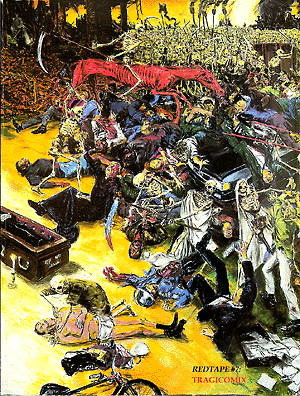The Downtown Collection: Documenting the Scene
- by Mike Kelly

Redtape #7: Tragicomix. (1992)
By Mike Kelly
The Bay Psalm Book exemplifies a quintessential American stance: a small group of outcasts moved into a new neighborhood and set up a press to promulgate their world view. Marching into the wilderness and clearing a space in which the voice of one’s community can be freely articulated is central to the American experience. “Americana” encompases all publishing formats and chronological periods in which this impulse can be found--whether motivated by religion, as in the Massachusetts Bay colony, or something less coherent and more difficult to define, as in the case of the Downtown Collection [housed at New York University’s Fales Library] that is the subject of this article. While many collectors of Americana focus on the major migrations and colonial movements such as the original settlements on the Atlantic or the progress of manifest destiny across the continent, this article contends that there are many smaller movements of people, communities, and subcultures worthy of investigation.
Greenwich Village and its environs feature prominently in any literary history of the twentieth century. E. E. Cummings, Edna St. Vincent Milay, Eugene O’Neil, and Dawn Powell are giants of American literature who wrote about the New York neighborhood in which they lived and worked. Any survey of private and institutional collections will show that printed books, artwork, manuscripts, and ephemera by and about these writers have been aggressively collected. This is true of later waves of bohemians, beats, and hipsters who took advantage of the cheap rents and cafes of the Village such as Jack Kerouac, William S. Burroughs, and Allen Ginsberg and whose works are equally sought after.
As the rents in the West Village rose, the next wave of bohemians moved south and east to occupy the derelict manufacturing spaces of Soho. As industry fled lower Manhattan, artists filled the vacuum and converted empty factories into residential and studio spaces. Cheap rents were also to be found in the crumbling buildings and drug-ridden streets of the East Village. In both neighborhoods, storefront galleries, hip new clubs, and trendy boutiques became the outlet for the creative energies of this new wave of Manhattan bohemians. The scene that emerged in these neighborhoods from the mid-1970s into the 80s and 90s is the focus of the Downtown Collection in the Fales Library at New York University. Since from the mid-nineteenth century NYU has served as host to Village writers and artists, it is appropriate that the works produced in our own back yard have found a permanent home here.